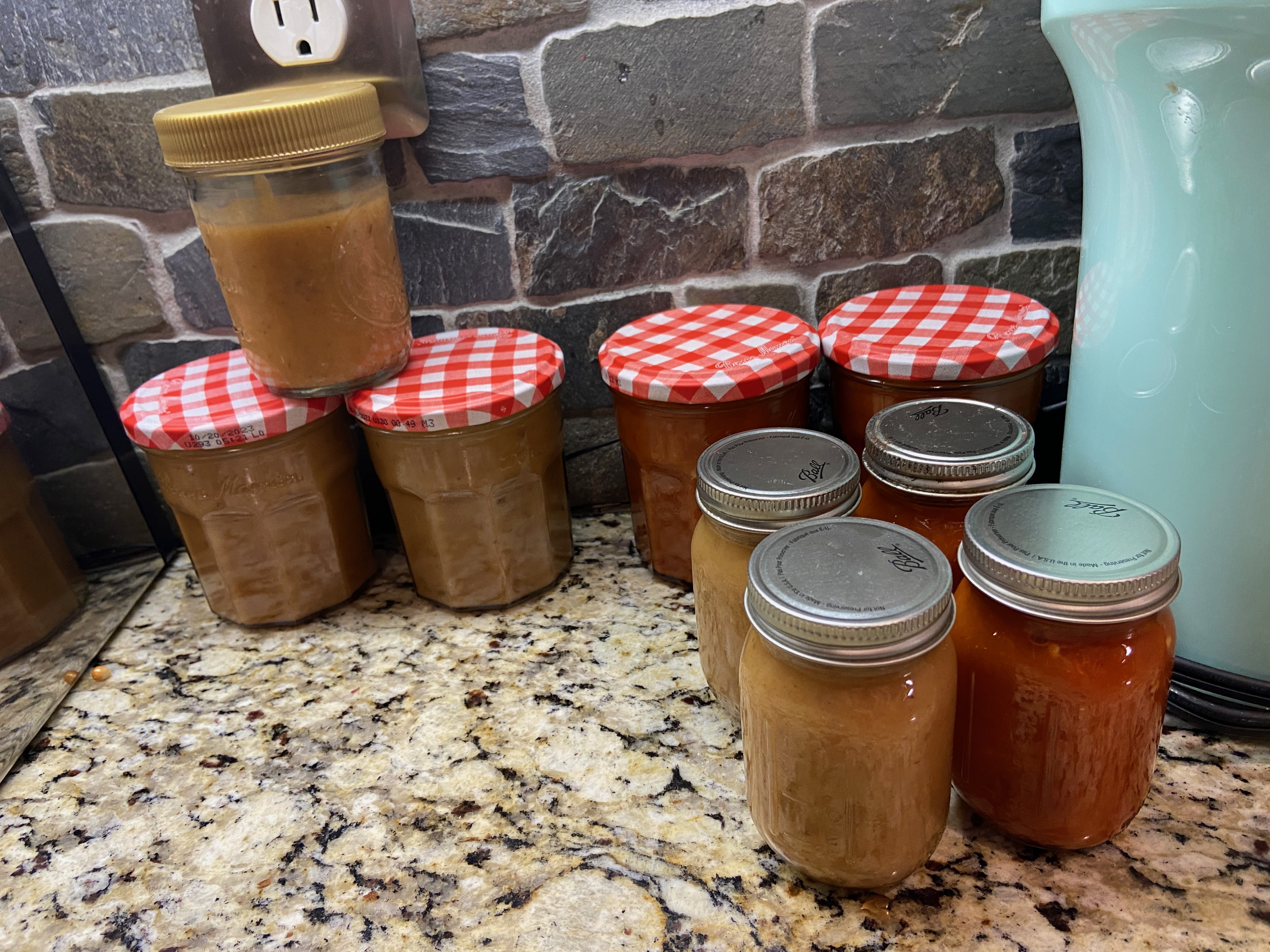
06 Dec 2022
Hello friends and relations. It’s been a while. It’s a beautiful day again.
We had our little Thanksgiving celebration. Our tradition has become a bit unusual: none of us really think turkey is that terrific a food to build a Thanksgiving meal around. The skin is the best part, but the breast? It’s basically poultry tofu, but dry, and most of the actual flavor comes from the gravy or dressing. So for the last few years we have opted to skip the turkey and order prime rib from Tippin’s Market in Saline. They did a fantastic job with the prime rib as usual. Their potatoes were great. Their green bean side dish this year was unfortunately only mediocre. It seems that they might have used canned beans. But still, it was wonderful to have other people do the serious cooking.
We picked up a bottle of 2017 Sanctuary Pinot Noir, which was quite nice with our meal. Then, after Thanksgiving, we bought five discounted whole turkeys to put in the freezer. (Hey, it takes a lot of vittles to feed our growing army of hobbits!) Over the next year we’ll use those up, roasting then, making sandwich meat or turkey salad out of the breasts, and turning the picked-over carcasses into broth. That way nothing will get wasted, but no one will have to eat a big slap of poultry tofu on Thanksgiving.
I also went out into the garden on Thanksgiving Day, with a little bit of snow on the ground, and harvested a bunch of goodies from our garden. The mild fall meant that we still had leeks, celery, sorrel, four kinds of sage, lemon verbena, lavender, mint, fennel, a couple of kinds of thyme, oregano, and other delicious things. We made chocolate mint tea.
Despite not being able to put much labor into it, we got a lot of food out of the garden this year, especially eggplant, grape tomatoes, leeks, and peppers. We got a few more raspberries this year than we did last year, as our canes are coming along, although they desperately need pruning. Before Thanksgiving we cut down all the parsley, which gave us a huge batch to work with. It had held up to a couple of very light freezes, but the weather that night was predicting a hard freeze, so it was time to harvest it or lose it. We juiced the stems and the juice was surprisingly sweet after the frost — parsley juice is usually bitter. We dried several large bags of parsley leaves and froze some more.
This week, Grace combined frozen and fresh peppers to make two kinds of hot sauce: a habañero sauce and a cayenne sauce. Together they amounted to over a half-gallon of hot sauce, which should keep our resident hot sauce fiend, Daniel “Pippin” Potts satsified for a while. I expect to harvest another big batch of leeks before the end of December, since they usually don’t become inedible until very cold weather arrives in January. Here’s a shot of some of the hot sauces:

I have a job again. I’m working as a contractor, this time for Boeing (indirectly, through a staffing company). Here’s my current workspace:
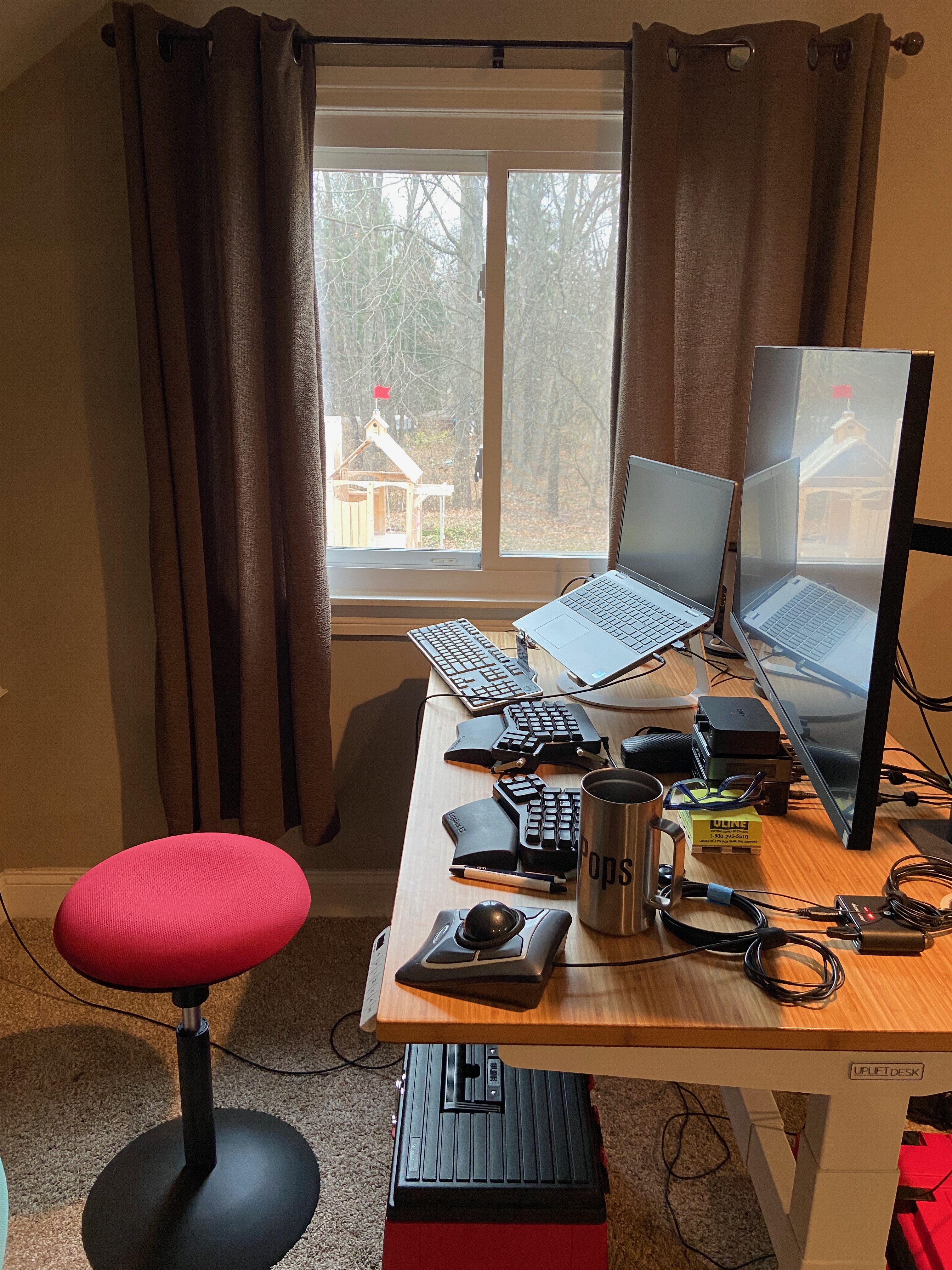
In my last newsletter, I mentioned that I was planning to start on November 18th. That date was pushed back. Apparently it took almost a month for the contracting company to complete the required background check because one county in particular, Saginaw County, wouldn’t get back to them. I didn’t have any sort of criminal record in Saginaw County, but they wouldn’t’t take my word for it. I’m not sure why Saginaw County was so slow to process this paperwork. I’m guessing that staffing problems due to the pandemic might have played a part, but I don’t know for sure.
Anyway, this meant that my first official work day was Monday the 28th, the Monday after Thanksgiving. All I did on that Monday was have two brief online meetings, one to verify my identity so that Boeing would send me a badge, which I need to get into my secure work laptop, and one to go over timekeeping for the contracting company. Then I had to wait another couple of days before I received my badge, late in the day Wednesday. I had a long call with Boeing’s IT department to try to activate my badge, but they couldn’t help me, and told me it would take at least another 48 to 72 hours before I’d be able to log in to the laptop.
That was discouraging, but I called the IT department back Thursday morning, December first, and got someone who was more helpful. He was able to get me into my laptop and from there I could access my Boeing e-mail, but not much else yet.
All these delays mean that my first full day of work was fifteen days later than I originally expected it to be, and my first paycheck will be for only 15 hours of work. Boeing shuts down for the whole week of Christmas, so I won’t be able to bill any hours at all during the week of Christmas.
This is not what I had hoped. I’ve never started a contract job that wasn’t full-time immediately. I’ve always been put through some sort of planned orientation and onboarding process. So this is awkward, and we are unfortunately continuing to drain our savings, but I’m glad to be working again, and I remain hopeful that in 2023 I will be able to bill full-time work weeks consistently, and also have some interesting work to do. The latter unfortunately has to be a secondary concern at this point.
I’ve set my work hours to Mountain Time, at least for now, because that seems to work pretty well with my team members who are scattered across different time zones. Aside from the team members in India, that is. They wind up shifting their hours enough to overlap with ours, so that they can attend online meetings.
This is the time of year, leading up to the shortest day, when I really would like to hibernate — to get extra sleep, to read books, to watch movies, to nap. Our home is not suitable for that at the moment. The kids have been keeping us up very late so Grace and I are rarely able to get to sleep before 2 a.m. Elanor and Malachi both threw a lot of screaming tantrums yesterday, for reasons we’re not entirely sure of. Grace had to take them for a drive for a while. When she brought them back they both started screaming again. Our teenagers like to argue. I just want some peace.
It’s cold in the upstairs today where I’ve set up my home office. I’ve put layers on and I’m sipping hot tea, but it is difficult for me to type or write because my hands are cold. I’m not sure why it is so cold. This time yesterday, it was hot up here. The outdoor temperatues haven’t changed much. I’m not sure why the heat in the upstairs zone sometimes fails to come on. All the thermostats seem to be on, with fresh batteries, but they don’t always seem to control their zones properly. Really, we need to get someone out to look over the heating system again, but we’re very hesitant to have a contractor come in; the post-Thanksgiving COVID surge is underway and it’s likely that previous infections have left all of us with damaged immune systems, and extra-susceptible to other circulating viruses.
I’m happy to report that IKEA had some of our HAVSTA bookcases back in stock, so I was able to buy three more brown bookcases for the upstairs. All three are set up now and filled with books on programming, Computer Science, and math. Most of these books came from the small windowless room in the basement which will now be a combination server room and storage room, and no longer an office. Here’s a shot of the new bookcases before I finished filling then up:
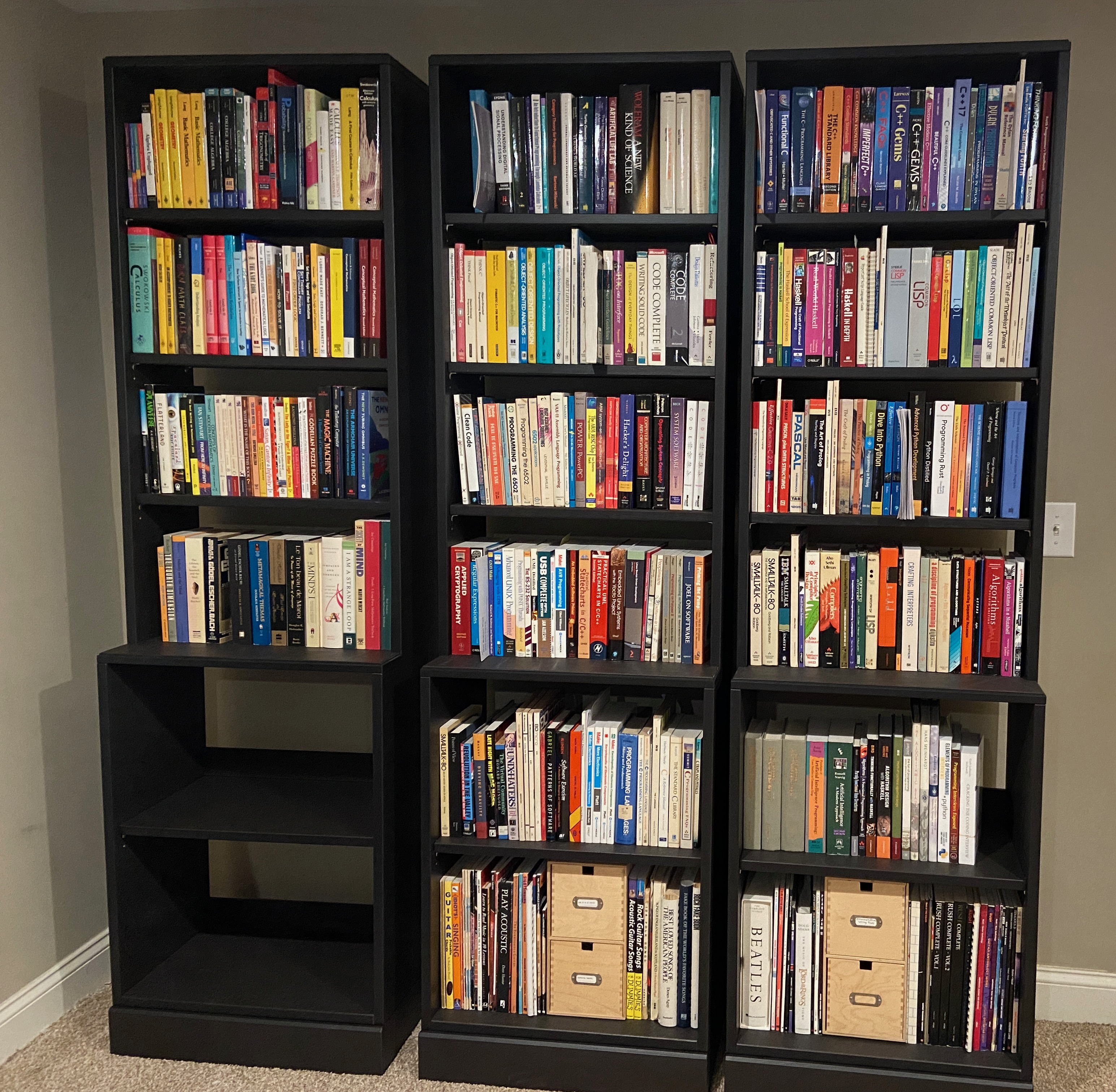
The programming-related books include books on specific programming languages, algorithms and data structures, compiler and interpreter implementation, operating systems, software tools, and the history of programming, including the history of artificial intelligence. The math books include a variety of books ranging from basic algebra through calculus, logic, analysis, lambda calculus, and category theory. These blend into books that apply these kinds of mathematics to digital signal processing and functional programming. There are some books on the more mathematical side of physics, including Susskind’s “Theoretical Minimum” series, and Roger Penrose’s incredibly dense opus The Road to Reality. There are also a number of books on recreational mathematics, which include works by Douglas Hofstadter, Martin Gardner, and Raymond Smullyan.
On the three lowest shelves are all my sheet music books and music instruction books as well as some little wooden drawer units filled with USB cables, Lightning cables, and other cables that the kids and I commonly need.
I’m very pleased to have almost all of these books in once place, although there are still some oversized books in the basement on Macintosh and Newton programming, bound printouts of various C and C++ standards, and some other books such as MISRA standards and the works of Edward Tufte. Over time I ought to be able to continue to rearrange and organize the collection. I don’t usually purge books from this collection since part of its value is that it contains a lot of historic books. I may not ever write programs for the Newton or Macintosh again, but these books remain indispensible for me to use as inspiration when I want to design user interfaces or APIs. Sometimes I get rid of books that cover obsolete versions of programming languages, but it’s not uncommon to need them again when I find myself having to work with older software tools, so it can be hard to decide what to get rid of. In some cases I have let go of printed copies of an old book but then downloaded a PDF file of the scanned book from the Internet Archive.
The Tufte books will probably come upstairs, and some of the physics books will go downstairs into a rearranged science section. The books on electronics might go with them. Some books on user interface design, the history of computer systems, and (building) architecture don’t fit easily into one category. Programming books blend into historty and Computer Science. Physics books blend into math books. Artificial intelligence blends into philosophy.
Anyway, because our Suburban isn’t running, I had these three bookcases delivered instead of going to do curbside pickup. That didn’t go very well. The delivery driver backed a big truck up our driveway and somehow manage to veer so far off course that he wiped out one of the galvanized steel fire rings that we’ve been using for raised beds.
I had added a note to the delivery instructions when I placed the order warning drivers to be cautious backing up the driveway, but this driver, probably a sub-sub-contractor of some kind, never got them. He did give us fifty bucks to cover the cost of the fire ring. There’s a margin for error between the driveway and the beds, which I thought was sufficient, and no other delivery driver has ever hit the beds, or come close to hitting the beds, but apparently the margin for error isn’t big enough, so I will not replace the bed in the same place.
We’re using brown bookcases on the ground floor and upstairs, and white bookcases downstairs. We have a total of 22 so far. That’s 22 IKEA HAVSTA bookcases I’ve assembled over the last few years. I could still use four to six more white ones in the basement, and then I think we’ll have all we need. The white ones have not been in stock for a number of months, but I keep checking. I want to be able to snap them up before they go out of stock again. I guess I’ll try again to get them delivered and hopefully it won’t result in any more collateral damage to our garden beds.
In November I helped Grace with a project that required us to shoot video in our home. The assignment was pretty simple: she wanted Grace to read some short excerpts from a book. But the details of the project were not so simple. The producer wanted us to shoot video at 4K resolution, 24 frames per second — the frame rate that films use. This is professional quality, or close to it. This was a challenge, since although I had small camcorder, it would not shoot video with these settings. We didn’t have any video lighting gear. I had some audio recording gear including my Sound Devices recorder and a small shotgun microphone I bought in 2020, for the kids to use with remote choir lessons over Zoom, but it didn’t seem like the best choice for this task.
I’ve done some video production and editing before, as part of my work back in the early 1990s when I helped produce instructional multimedia for the University of Michigan, so I wasn’t completely unfamiliar with lighting and shooting video, but the gear has changed an awful lot in thirty years. Back then we were shooting analog video, and editing it on a hybrid analog/digital system. I’m much more familiar with audio now than I am with video. And back then I was shooting in offices, quite close to the subjects, which were framed like newscasters, not like scenes from a film.
The first challenge was to put together a minimal acceptable rig for shooting video. I looked into what it would cost to buy a standalone camera that would shoot 4K video at 24 frames per second. The lowest-budget solution I could come up with was actually to purchase an unlocked iPhone 13. I set it up for Wi-Fi and didn’t configure it to make calls; it’s now called “Cambot” after the camera robot in Mystery Science Theater 3000, and is reserved just for streaming and recording video.
We had a tripod, so to mount the iPhone on the tripod, I bought a small metal frame from iRig that snaps around the phone and allows attaching a handle, a tripod, or other devices that use a “cold shoe” camera mount. It was possible to attach my shotgun mic to the cold shoe mount, but I decided to get a RØDE wireless lavalier mic kit, so that Grace would wear the microphone. I also bought a low-end LED lighting kit, the GVM 800D LED kit, whih comes with three lights, along with a fabric diffuser and a couple of “soft boxes” to diffuse the light.
When everything arrived I did some testing. The iRig case for the iPhone is a very clever and flexible piece of gear and I’m quite happy with it. I can attach a handle and carry it around to do steadicam-style shots, or mount it on a tripod, either a short one to use on a tabletop, or a taller one to use on the floor.
The lighting kit was, as I thought it would be, very cheap both in price and in quality. The stands are quite flimsy, the panels themselves feel a bit fragile, the carrying case is made as cheaply as possible, and setting up the remote control was difficult to figure out. But if you handle the light panels with kid gloves, they actually work really well. And the lavalier mic kit produced great results very easily — I’m always very impressed with RØDE gear. I am expecting to do some more video projects with the phone, such as live streams. My previous attempts at live streams haven’t gone very well, but having this stuff all ready to go should help. If I wind up using the lights frequently, maybe I’ll upgrade the tripods they came with.
Our producer wanted me to shoot with deep space behind the speaker, so that the background would be quite a bit further back, and slightly out of focus — like I said, a more “cinematic” look than a typical talking head at a desk look. She had sent some examples of what she was looking for — still frames which included people speaking in front of big beautiful rooms with picture windows, or outdoors. We didn’t have a suitable spot on our main floor. A lot of the walls on our main floor have been heavily dirtied and drawn on by the kids over the last few years, but we don’t want to put money into repainting until the youngest kids are beyond that stage. I considered shooting on the deck, but it was quite windy, and that wasn’t going to work. The upstairs was also a mess. But the younger kids have never been allowed in the basement without close supervision since we moved in, so the walls are almost pristine. There’s a large open space, which we are setting up as our library. It just wasn’t ready for use, at all.
So, the next big challenge was to do some major reorganizing downstairs, to open up spaces where we could shoot. Getting the basement library space fully usable had been a goal for a long time. I was not yet working but I had a start date, so I felt comfortable suspending my job search for a while, and could put in a number of full days down there. Getting the room ready required several full days of my work, and some half-days of Grace’s work, and the kids’ help, to get close to the goal. We had to empty and disassemble a big three-part shelving unit, finding homes for all the things on it. In fact, we managed to get a great backdrop for shooting, but just barely — there was still a lot of stuff (boxes and boxes of it) just out of frame, and if we wanted to point the camera elsewhere we had to scramble to rearrange the stuff. Doing the work to set up this video shoot really got us over the hump or organizing the basement, though, and since then we’ve managed to continue to make steady progress towards getting things set up the way we want them.
My first setup involved shooting against the fireplace in our basement. The big “table” is a door that I originally bought back when we lived in Saginaw, to use as a desk, and stained dark brown:
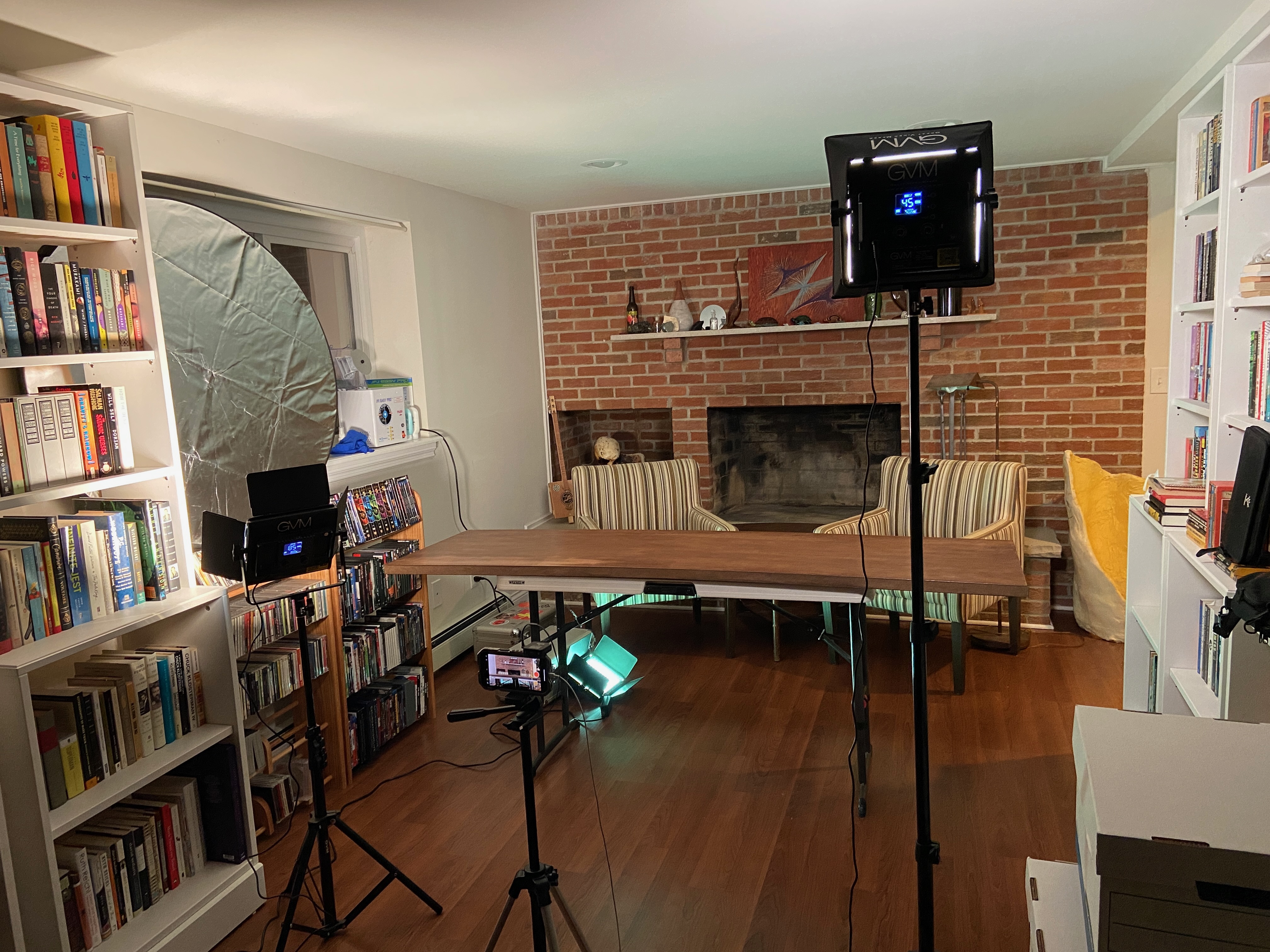
There’s a little extra stuff there, but the camera couldn’t see it. Here’s a test still shot with Joshua as a subject:
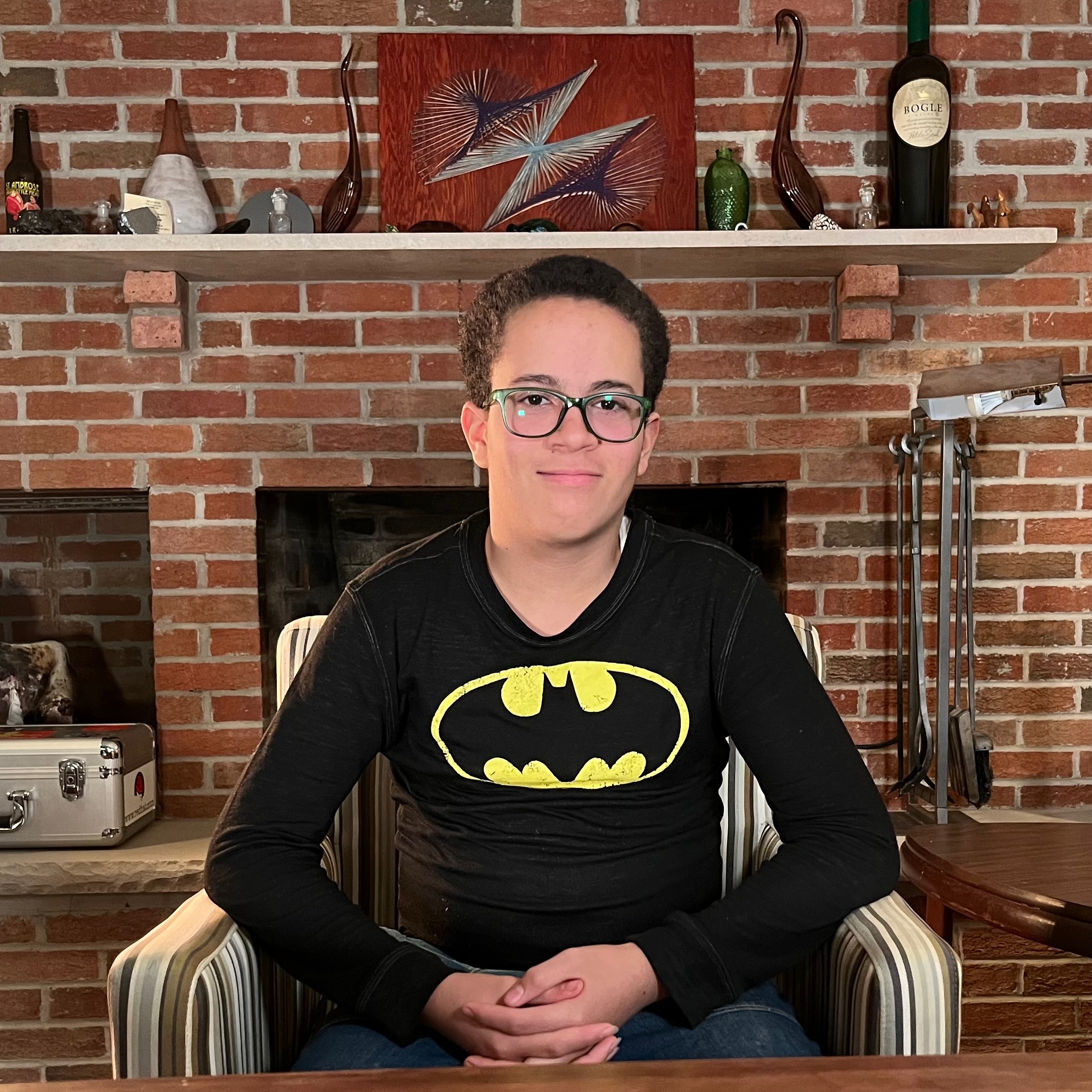
That looks pretty good, and the background supplies some extra visual interest, but the background isn’t as far back as we want, and Joshua doesn’t really stand out from the background very much; even with my lighting, it’s too “flat.” When Grace saw this setup, she didn’t really like it either — she thought we could get a deeper background by shooting from the hallway into the library. She was right, so I gave a deep sigh and rearranged everything to try the next day.
The LED lighting is capable of wild colors, but for this setup I wanted more natural look. I used all three panels combined with some late-afternoon sunlight (blocking out some of the light coming in from the windows, but keeping a little bit of it). I used one panel as a key light, one panel as a fill light, and the third as a “hair light,” with a yellow-orange tint, shining in from the side, to help Grace stand out from the background.
Here’s how that new setup looked from in front of the camera, showing the lights, along with some leftover boxes we hadn’t found a good place to put:
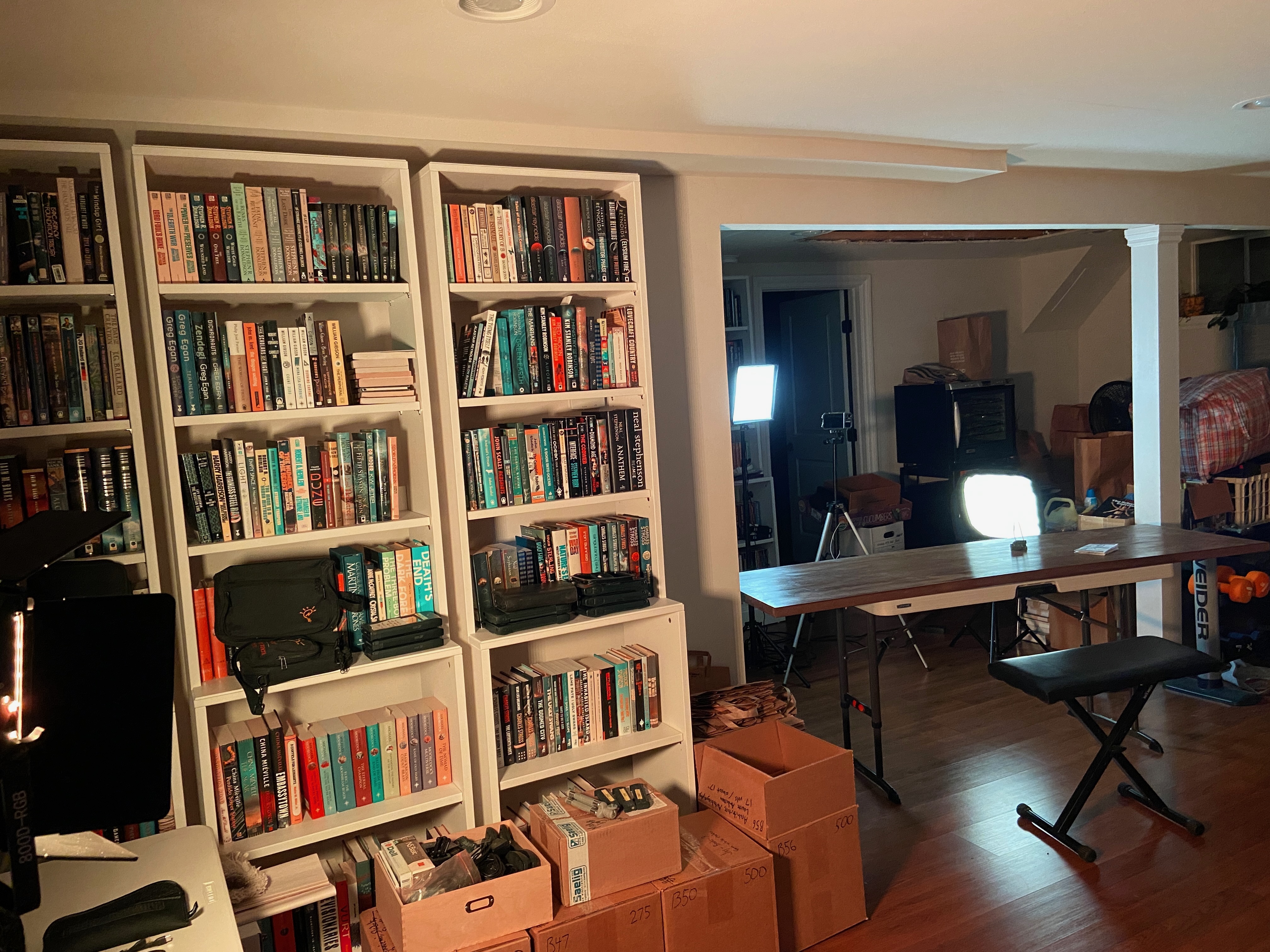
Here’s a shot from behind the camera showing the three LED lights (the fill light is low, and shrouded in a “softbox”), including the orange-ish “motivated” reading lamp:
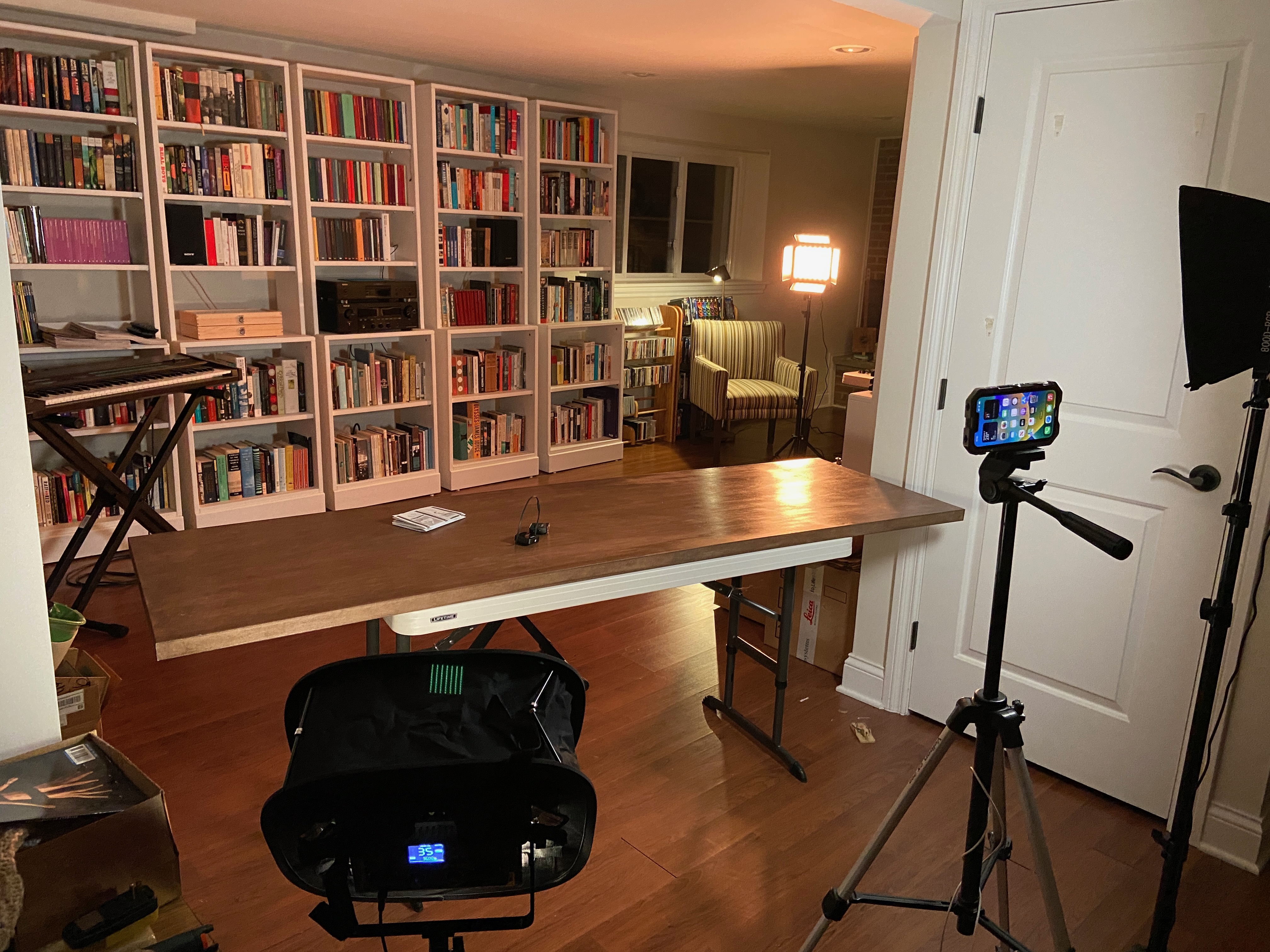
Here’s what the camera “viewfinder” (that is, the iPhone screen) looked like when I was shooting. You can see the iRig frame that is holding the phone, mounted to the tripod:
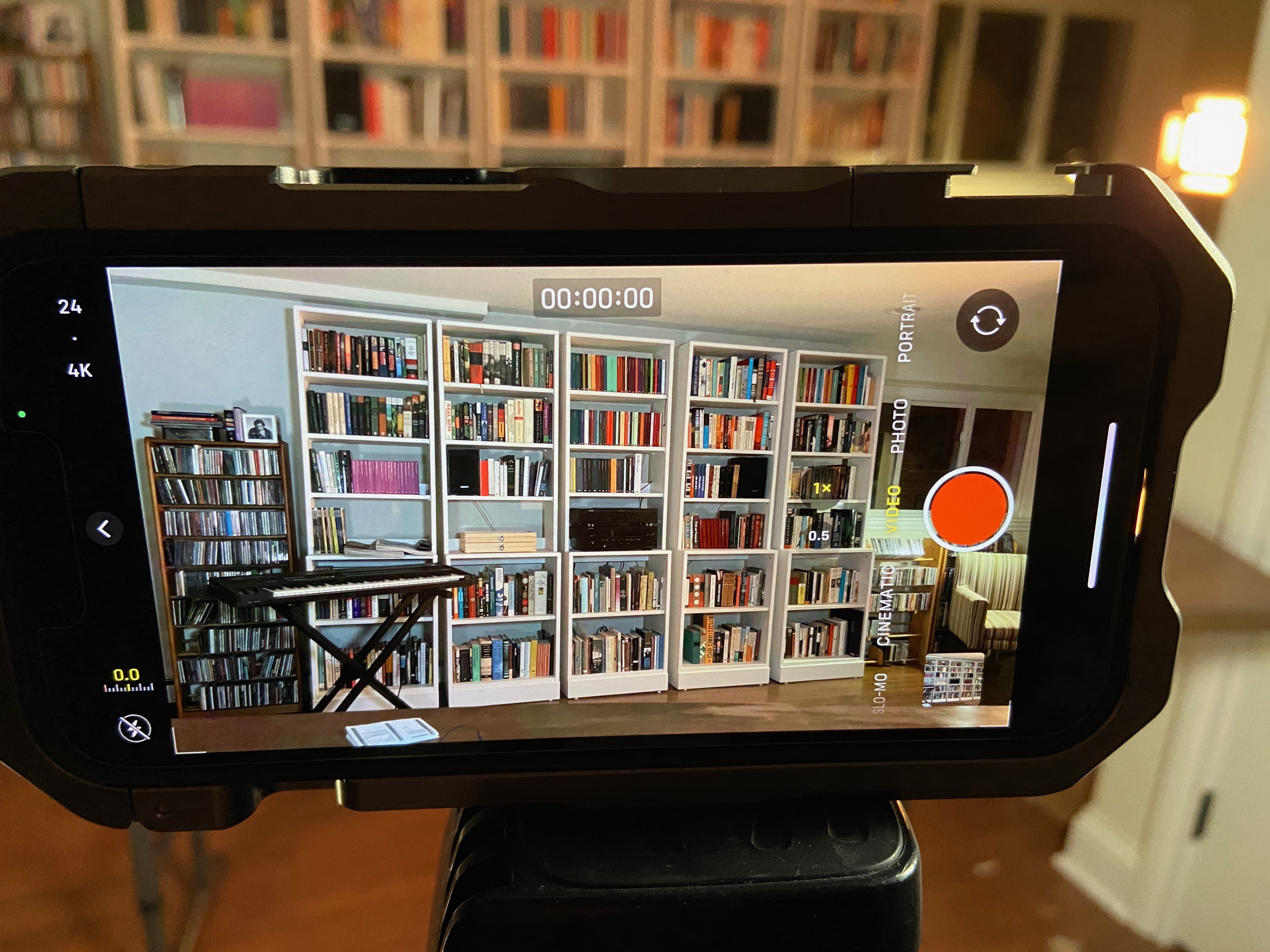
In order to make the orange-ish hair light “motivated” — that is, to make it look like the light was coming from a visible source, not just coming in from off-camera — I put a reading lamp in one corner. Of course the reading lamp isn’t really capable of providing all that light, at that angle, with that color, but unless the viewer looks at it closely, they probably won’t realize that. In a “talking head” shoot with a person at a desk, it’s well-understood by the viewer that the person on camera is in a studio, so they assume all the lighting is artiical anyway. But in this kind of a setup, in a room that is clearly a real room in a home, this kind of motivated lighting looks more natural, like the lighting often used in films. Here’s a zoomed-in bit of the resulting video, showing how the natural light and video lights came together to produce highly artificial and contrived, but in my opinion quite natural-looking, lighting:
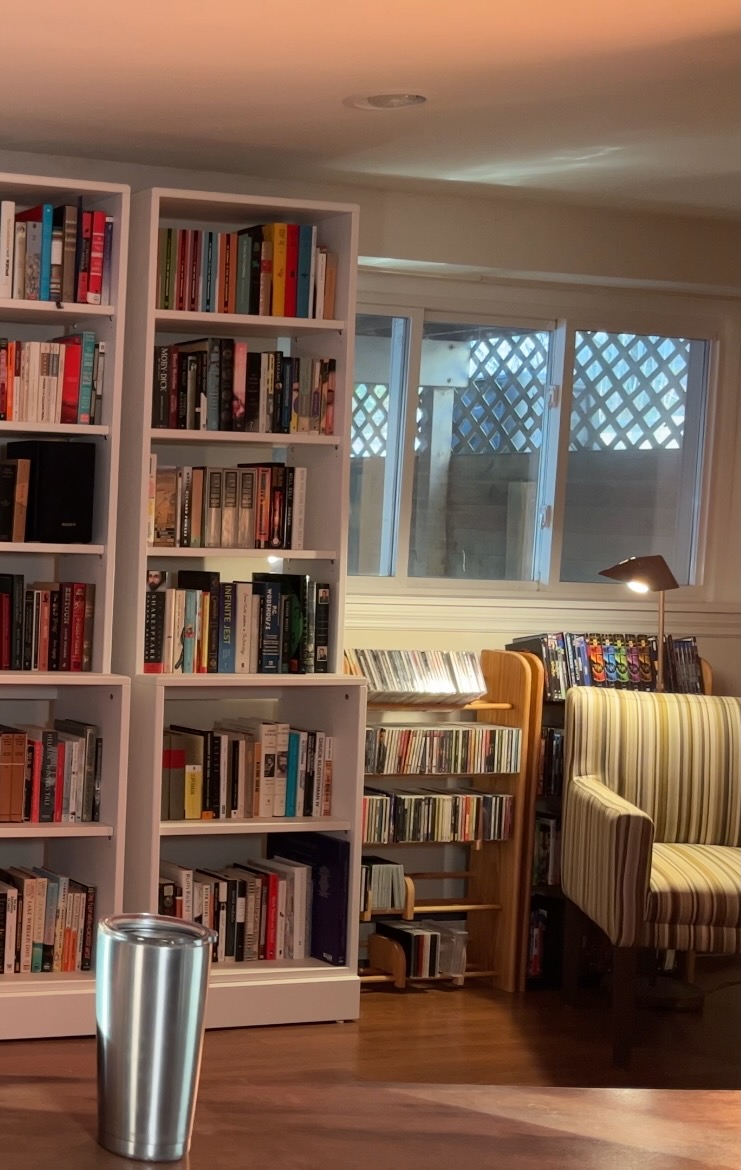
In this picture you can see the partially-blocked sunbeams coming in from the windows off-camera:
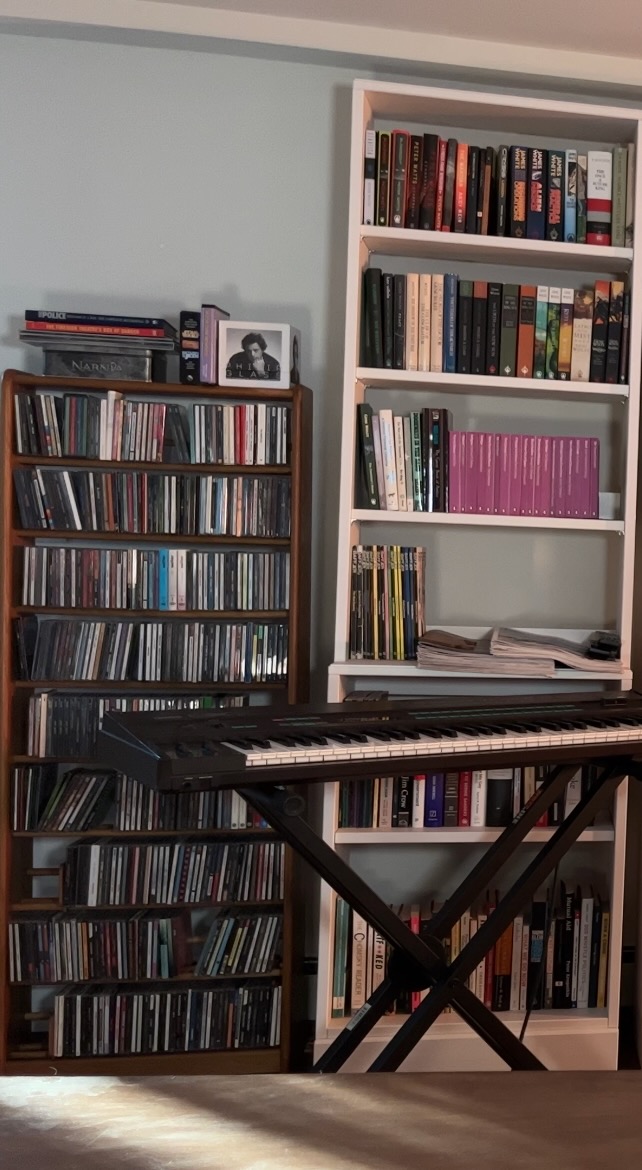
The sun was low in the sky, and the light coming in from the windows was rapidly shifting, changing noticeably from minute to minute. So we had to complete our shot fast, while we still had that light! But the combined light sources looked great, and unless the producer directly cuts between video from the beginning of the shot and video from the end of the shot, with nothing in between, the difference shouldn’t be too noticeable.
I found a few YouTube videos that helped get me up to speed, and served as inspiration. This video showed me examples of how to use the lighting kit to create cinematic lighting effects. Of course, I didn’t do anything quite this dramatic with our lights, but it helped me think about various possibilities.
This video served as a good refresher on three-point lighting, including a “motivated” hair light.
And finally, this video taught me how to use the iPhone 13 video settings, some of which are a bit hidden unless you know where to look.
The fact that these settings are hidden is a design choice on Apple’s part: the iPhone camera is meant to be a simple, point-and-shoot camera that will give decent results for most users, without changing any setting. But the settings are there if you want to try them.
I’m a bit embarrassed to admit that I didn’t already know how to use the various settings, but it makes sense given that I didn’t own an iPhone of any kind until last year, and my phone is an iPhone 11, which doesn’t have as many options as the iPhone 13.
I considered buying a new iPhone 14, as the price wasn’t much different, and the 14 supports the “ProRes” codec that our producer suggested, but no one seemed to have an unlocked iPhone 14 in stock. I also considered the “Pro” and “Pro Max” models, which have more lenses, more features, and bigger screens, but for this kind of indoor tripod-mounted video shooting, there wasn’t really any need for these bigger models, the price increase was large, and there were also availability problems.
Anyway, after I had the footage, consisting of multiple takes of Grace reading each passage in a continuous file, I had to figure out how to upload it. This led me to learn how to use the AirDrop feature. It was a bit difficult to configure and I had to use Google and make a few guesses, but once I got it configured correctly, I discovered that this feature would let me send large files (this one was three and a half gigabytes) directly from Cambot to my laptop. These files were much too big to send by e-mail, but I was able to put them in a folder on our web site where our producer could download them.
Since this was our first attempt, I thought we might get some notes back from the producer, and have to try again. But fortunately she liked the video as it was!
I don’t have details on the finished product yet, but I’m told that the project should be completed early in 2023. I’ll share the details as I learn them.
Okja is a film by Bong Joon-ho, the director of Snowpiercer and Parasite. This was a Netflix production, and we don’t subscribe to Netflix, but recently the Criterion Collection released it as a Blu-ray, so I got my hot little hands on a copy during their half-off sale in November.
Okja is the story of a young girl and her pig. That makes it sound like an updated Charlotte’s Web, but the story isn’t very similar. In Okja the titular pig is a giant genetically-engineered creature bred for agriculture, raised on a traditional farm in Korea for PR purposes. Okja was created by the Mirando Corporation, a giant agribusiness, headed up by Lucy Mirando, played very weirdly by the queen of very weird roles, Tilda Swinton. When the company representatives including a washed-up TV show host Johnny Wilcox, played by Jake Gyllenhaal, show up on the farm, the story kicks into high gear. The girl, Mija, played by Ahn Seo-hyun, isn’t happy to learn that her friend Okja is going to be taken away from her. She takes matters into her own hands, but her fight is soon joined by the Animal Liberation Front, who carries out a daring raid to free Okja and expose the misdeeds of the Mirando Corporation, and we’re off to the races.
Bong is a terrific director and really knows how to work with actors. The cast of Okja all do great work, but Tilda Swinton stands out for her portrayal of Lucy, as well as Lucy’s twin sister. Giancarlo Esposito is also great as Frank Dawson, Lucy’s assistant, who gets most of the actual work done while Lucy imagines that she runs the company. This leads to a number of very funny moments in the fillm.
Okja is an animated creature, generated by computer, but looks much more convincing than most computer-generated creatures. In fact, I’d say this is some of the best fantasy creature animation I’ve seen since Gollum in Peter Jackson’s Lord of the Rings movies, which was a really a huge milestone in computer animation, built on top of a terrific performance by Andy Serkis. In Okja, there are a lot of moments when the cast physically interacts with the giant pig, pushing the pig up a ramp into a truck (a wonderfully convincing shot), or even riding the non-existent animal through a shopping mall (a hilarious scene reminiscent of the car chase through a shopping mall in The Blues Brothers).
These scenes weren’t just shot against a green screen with the actors pretending to interact with nothing. There were a lot of practical puppet effects involved during filming. Mija’s interactions with Okja are especially convincing, because she was really interacting mostly with one real human puppeteer carrying a “real” fake pig, if that makes sense.
Okja is a fantasy, but it’s a dark fantasy, featuring fantastic performances, and it makes for a convincing satire and commentary on now, not some distant future. I wouldn’t recommend it for young children, but it was fine for teens.
I found this film on the Criterion Channel’s streaming service. It was directed by New Zealand directory Taika Waititi, and shot in New Zealand, so you’d better believe there are some Lord of the Rings references. It features Sam Neill, an actor I always enjoy watching, and Julian Dennison, who plays a 13-year-old Ricky Baker.
Ricky Baker is a ward of the state, and a foster care hard-case. His child welfare officer, Paula, takes him to live on a remote farm with foster mother Bella (played by Rima Te Wiata) and her husband Hector (played by Sam Neill). Bella is a wonderful character, doing her best to make life better for young Ricky Baker, while Hector looks sourly on, not really interested in the project of parenting. Bella only appears in a few scenes, but the sensation of her presence remains for most of the rest of the film. When Bella dies, Paula plans to take Ricky back to the tender mercies of the state child welfare system. Ricky isn’t happy about this, so he plans to run away. And so begins the adventure.
The film flirts with sentimentality, but ultimately never falls into that trap; the relationship between Hector and Ricky is portrayed very, very convincingly precisely because both damaged, anti-social people don’t suddenly become buddies as they flee together into the bush — that just wouldn’t be be realistic. I won’t give away any more of the plot, because the twists and turns are worth it. The wild landscape of New Zealand is another character in this film, and it’s fascinating. It’s a really fun movie — funny, sad, and beautiful. Taika Waititi’s next film, Thor: Ragnarok, came out the next year, in 2017.
I first saw Thief, director Michael Mann’s first feature film, back on VHS tape. My stepbrother had taped it off of HBO. I must have been fourteen or so. I don’t remember much about it. Recently I listened to the We Hate Movies podcast review the film, and since I had recently watched Michael Mann’s next film, The Keep, I wanted to try this one.
It’s a gorgeous “neo-noir” film, a heist film, where oddly, the big heist is not the point in the film where the drama peaks. It follows an ex-con, played by James Caan (yes, Caan is a con), in an amazing performance, and also features Tuesday Weld as Jessie, who becomes his wife. Robert Prosky plays Leo, in his first big film role, and it’s also an amazing portrayal. Willie Nelson and Jim Belushi also play supporting characters in this film. Willie Nelson’s character is especially compelling on-screen; I had no idea he could act. This really showcases Mann’s skill at working with actors.
Right from the start it’s clear we’re watching a visually stunning movie, with beautiful nighttime cityscapes flowing into a long shot of Lake Michigan at dawn. Thief takes its time to let the scenes play out, but never feels slow. The scene where our protagonist meets with Jessie in a diner is one of the most compelling “relationship” scenes I’ve ever watched in any film — a very twisted, but convincing moment between two damaged characters. There are many more great scenes, including a hilarious scene of a judge arranging for a bribe, right in open court. The screenplay is terrific. You have to pay close attention because a lot of the plot points aren’t discussed out loud by the characters, as screenplays often do, but everything you need to know is right there on the screen.
The film’s follows our ex-con trying to reclaim his life after one more big score. There are a lot of scenes of criminals with wonderful ugly cinematic faces doing their jobs in a very workmanlike ways. In the big heist, we see the team use a thermal lance, or “burning bar,” to cut through heavy steel plating. The thermal lance is a big steel tube filled with steel rods and connected to tanks of pure oxygen; they light it with an oxyacetylene torch and the steel rods in it actually burn, raising the temperature of the tip to thousands of degrees, hot enough to go right through the steel safe. Our titular thief could cut a huge hole, and then walk right in. In the film, this scene is as beautiful as the tool is dangerous.
To coin a metaphor in my usual awkward way, this film burned through the complacency of viewers and critics in 1981 as effectively as that white-hot burning bar burned through the safe, and Mann was then able to just walk right in and grab the diamonds inside: deals to produce future films with A-list stars.
As I mentioned, the end of the heist is not the end of the film. The real ending is shocking and brutal, but plays out in a way that feels inevitable. This one is definitely not for young kids. Sam enjoyed it a lot, and Grace and I both enjoyed it a lot, too.
I’ve continued to take nattokinase and serrapeptase daily, to treat my long COVID symptoms. In fact, I’ve increased my dosage of nattokinase. This seems to be helping. The constant burning and tingling in my hands and feet has definitely lesssened. My various aches have not gone away, but they have improved. I’ve been able to do a bit more, physically, such as assembling those bookcases, without triggering a full-on crash into extreme fatigue. I seem to be sleeping a bit better despite the kids’ best efforts to keep me awake. Just now Joshua told me he was getting packages of tortillas from the basement. “I’m bringing up three,” he said. “That’s nothing,” I immediately shot back. “I’m bringing up seven.”
I take that as a sign that a little bit of my “brain fog” is lifting. I’m unclear on the exact mechanisms at work, but my understanding is that this probably means I’m actually recovering from post-COVID brain damage. See this article. (“Fog” sounds a lot nicer than “damage,” doesn’t it?)
I don’t know if this just means my daily regimen of pills is suppressing my symptons, or what would happen if I went off them. A lot of things about long COVID aren’t well-understood yet. Right now I’m not inclined to try, in case this means that the virus itself, or other damaged mechanisms in my body, find themselves newly liberated to undo what recovery I’ve experienced and do more damage.
I just learned in an online staff meeting that my team is having a big gathering in St. Louis in late January. Out of about 20 people in the meeting, it looks like everyone but me will be going. No one raised the slightest concern about the safety of this event. I was the only one to chime in and say that I would not be traveling for this. I didn’t want to get into a debate over whether attending the event is safe or not; I just assserted that I’m not able to do so. This was a hard requirement I made clear to the recruiters and to my manager from the start.
Why is no one else in this team of software engineers, people who rely heavily on having well-functioning brains, standing up to protect those brains? (Not to mention their hearts, lungs, and other vital parts; remember, as Emo Philips said, “I used to think the brain was the most wonderful organ in the body. Then I realized who was telling me this.”)
They don’t necessarily want you to actually die for your job, but apparently the trick is to convince them that you’re willing to die for your job. Given that I’m no longer willing to do so, we’ll see how long I can keep this one. I hope I don’t have to watch my co-workers get sick and impaired in their ability to do their work, as happened to one of my four team members at Argo, or worse. I think between the travel and the event, the odds that no one on my team will be infected (or reinfected) are very low. But I hope I’m wrong.
I’m going to wind it up there for today. Have a great week!
This content is available for your use under a Creative Commons Attribution-NonCommercial 4.0 International License. If you’d like to help feed my coffee habit, you can leave me a tip via PayPal. Thanks!
Subscribe via TinyLetter • Year Index • All Years Index • Writing Archive